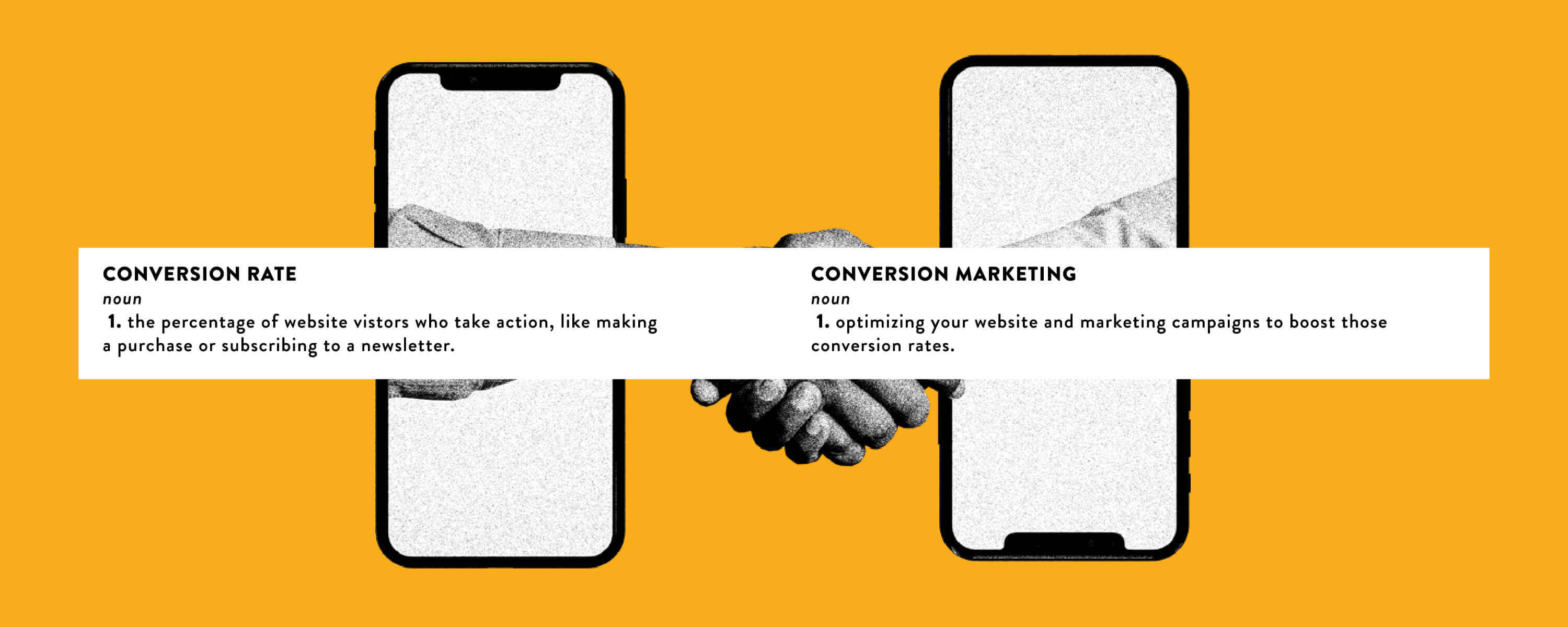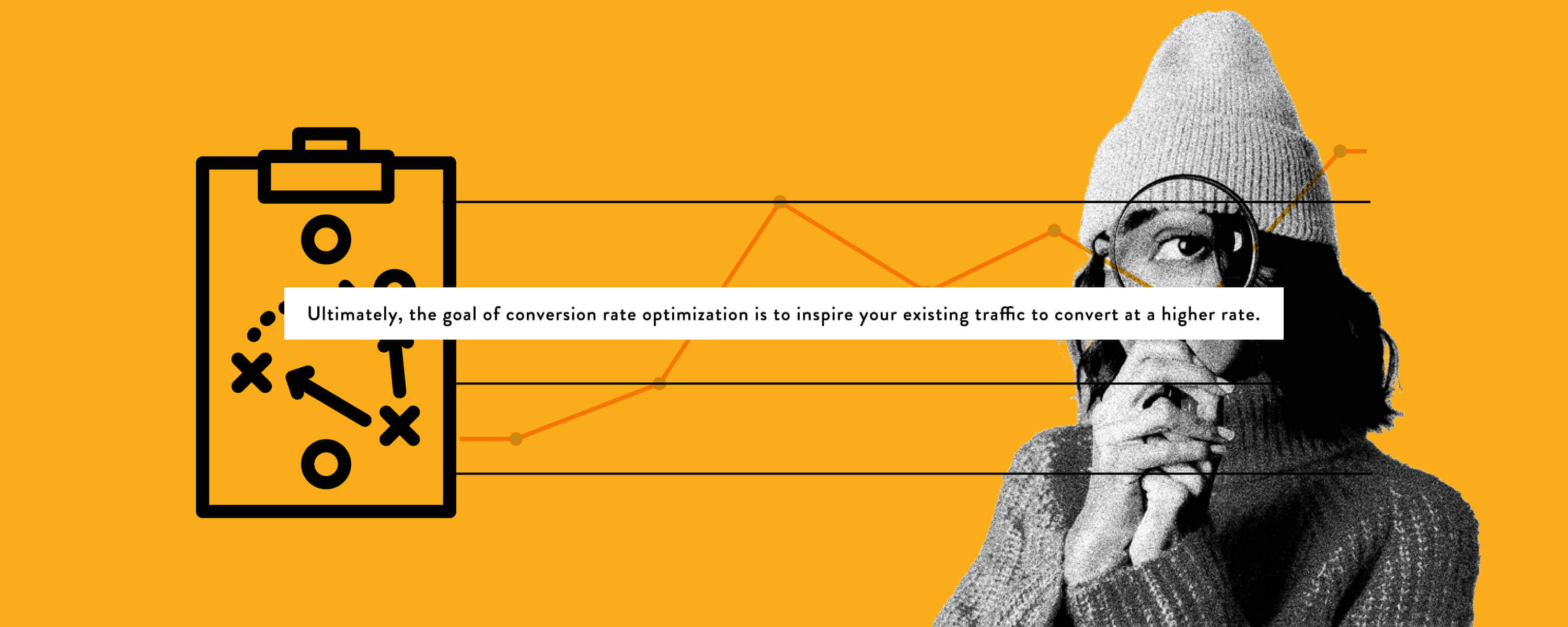What is Conversion Rate and Conversion Marketing?

Simply put, a conversion rate is the percentage of website visitors who take action, like making a purchase or subscribing to a newsletter. Conversion marketing refers to optimizing your website and marketing campaigns to boost those conversion rates. Optimizing existing pages and content for conversion rates is often referred to as conversion rate optimization (CRO).
It can be challenging to know what a conversion rate is. Let's break it down by looking at some common actions referred to as conversions.
What Counts as a Conversion?

When running a website, the end goal is to turn visitors into customers. That's where conversions come in. They are the actions that visitors take that align with the website's goals to secure customers. Some examples of different types of conversions include:
- Making a purchase: Visitors complete a purchase on the website.
- Signing up for an email list: Individuals submit their information to get updates and offers from the website.
- Downloading a resource: Customers access valuable gated content such as an e-book, whitepaper, or video in exchange for contact information.
- Submitting a form: Visitors enter data into surveys, contact forms, or quote requests.
- Reducing bounce rate: Users stay on the website for a longer duration of time than expected.
Ultimately, conversions refer to any desired action a visitor takes on your website. Marketers then use these numbers to track the effectiveness of their sites.
What Is the Conversion Funnel?
A conversion funnel, or marketing funnel, aims to turn website visitors into customers. The funnel guides potential customers through various stages of the buying journey to eventually lead them to a purchase.
The various stages of the conversion funnel include awareness, interest, consideration, and decision. Understanding this type of marketing funnel can help businesses identify gaps, improve user experience, and increase their ideal results.
Why Is It Important To Measure and Track Conversion Rates?

Conversion rates are crucial metrics for any business or marketer. They help you understand what percentage of users took the desired action, such as purchasing a product or service, signing up for a newsletter, or downloading a resource.
By tracking conversion rates with analytics software, you can gain insights into what's working and what isn't, improving your content and audience understanding.
Conversion rates can also tell you which channels are the most effective at generating new business on your site. Examples of these channels include:
- Pay-Per-Click (PPC)
- Organic Search
- Social Channels
- Direct Traffic
- Referral Traffic
Analyzing conversions by these different channels can help you understand the most effective way to convert website visitors.
For example, measuring your SEO results from organic search can help determine if you need to adjust different SEO tactics. Alternatively, calculating the cost per acquisition (CPA) and return on investment (ROI) from paid campaigns helps determine if investing in paid search is worth it.
To gain more business from your website, there are typically two paths: increase the amount of traffic coming to your website, or increase the number of conversions you’re achieving from your current traffic. Conversion marketing is the process of bringing in more traffic that converts at a higher level.
Furthermore, measuring your SEO results and pay-per-click (PPC) traffic can help you determine the most effective strategy for your website.
SEO tactics such as keyword optimization, content creation, and link building help increase your site’s organic traffic. Similarly, calculating the cost per acquisition (CPA) and return on investment (ROI) from paid campaigns helps determine if investing in them is worth it.
How To Calculate Conversion Rate

To calculate the conversion rate, you first need to determine what you’ll count as a conversion. For example, you may want people to sign up for a newsletter or purchase a product or service.
Often within a single site, there can be multiple conversion goals, which can make tracking and analysis more complex. For this reason, you may have to create additional conversion rate calculations based on different goals.
Additionally, you may want to calculate conversion rates for different sources of traffic. For example, you may want to know how direct traffic conversion rates compare to organic, and how organic compares to social. This is because each traffic source will bring in a different audience, who will interact with your site differently and have different conversion effectiveness.
Understanding these different goals and how they relate to your company's overall business objectives is essential in determining your conversion rate and developing effective marketing strategies.
Conversion Rate Formula
A simple conversion rate formula divides the number of desired actions — purchases, completed forms, downloaded resources — by the amount of traffic to your site. For instance, to determine your own conversion rate, divide the number of conversions by the total amount of traffic to your site. For example, if you get 50 conversions from 1,000 clicks, your outcome would be 5% (50 divided by 1,000 equals 5%).
You can identify which campaigns are effective by tracking and comparing different campaigns over time. This will help you optimize your campaigns and increase results in the future.
Key Metrics for Measuring Conversion Rate
To ensure your website converts visitors effectively, you must track and analyze key metrics. Tracking these metrics can help you identify opportunities to optimize your website and marketing campaigns, leading to increased results and revenue.
Some of the most important conversion rate metrics include:
- Click-through rate: the number of visitors who click on a CTA.
- Bounce rate: how long visitors stay on your site.
- Return on investment: how much you make on your campaigns.
- New visitor conversion rate: how many first-time visitors use your site and make a purchase.
- Returning visitor conversion rate: how many second-time visitors use your site and make a purchase.
- Average time on site: how long a visitor stays on your site before making a conversion.
The metric you track is determined by your business goals. Are you investing in a new traffic channel? Tracking ROI can be helpful. Alternatively, if you are A/B testing a new contact form, tracking click-through-rate may give you valuable insights.
Tracking these metrics can help you identify opportunities to optimize your website and marketing campaigns, leading to increased results and revenue. So, ensure your traffic is qualified and use the insights to improve your online business.
Analytics and Conversion Rate Optimization
Analytics tools are essential in gathering valuable data from various channels, including web traffic, social media, and mobile apps. This data provides insight into customer behavior, preferences, and trends, which helps businesses create marketing strategies that convert more leads into customers. A few popular analytics tools are:
- Google Analytics: Get insights on traffic, user behavior, and other important information that can help you improve your site. The tool also allows you to track conversions and generate detailed reports.
- Facebook insights tool: You can see the types of posts that get the most engagement, track conversions from ads, and measure performance metrics.
- Lucky Orange: This heatmap tool can track where your visitors are drawn to on your website pages. It sends you recordings of customer journeys so you can track the effectiveness of your site.
- HotJar: This tool also provides heat map data to understand customer journeys and workflow.
- Optimizely: This platform allows you to easily A/B test different conversion tactics.
- OmniConvert: Create personalized experiences for your website visitors based on different demographics.
The tools also help organizations track the performance of their marketing campaigns, provide insight into conversion rate optimization, and identify areas for improvement. Implementing analytics tools in your business can help streamline operations, identify new revenue opportunities, and enhance your overall marketing goals.
Strategies for Increasing Conversion Rate

Once you have gathered data on conversion rates, the next step is to analyze and comprehend the performance of your site. The data you interpret will help guide you to the right conversion rate strategy for your business.
Conversion Rate Optimization (CRO)
Conversion rate optimization is the practice of testing changes on your current site to increase the number of conversions you’re achieving with your current traffic and audience.
Common CRO elements to test:
- Split test different copy on landing and product pages.
- Add CTAs to high-trafficked pages.
- Add lead flows and pop up forms to your blog content.
- Test different design to change the way users interact with your site.
- Test different images to feature your products or services.
Ultimately, the goal of conversion rate optimization is to inspire your existing traffic to convert at a higher rate. That means you want the people visiting your site to fill out to make a purchase. Ruthlessly test copy, design, UX, imagery, and all other elements that help support the purchase decision on your site.
Enhancing User Experience (UX)
User experience (UX) plays a critical role in influencing your SEO and conversion rates. If your website or app is easy to navigate, visitors are more likely to stick around and convert using your site.
Simple tweaks like minimizing page loading time can make a huge difference in a user's experience. This can reduce bounce rates and improve conversions by ensuring visitors spend more time on your website or app.
Clear calls to action (CTAs) can also help guide users toward the desired action if they are impressed with the rest of your site’s UX. CTAs should be placed in prominent places and use language encouraging people to click. A visually appealing layout, intuitive design, and personalized recommendations are other ways of enhancing UX to promote conversions.
Increasing Organic Visibility and Traffic
Organic traffic is one of the largest sources of traffic on the web, and for many businesses. Search is a common channel to grow the overall traffic to your site, and therefore your total number of conversions.
Here are some common elements of growing your organic search presence and traffic:
- Build links to your site: This method involves actively seeking out and building organic and relevant links with website owners, resulting in backlinks that can help rank your site higher. Creating linkable content that other websites naturally want to share and link to can help expand your target audience and bring in more traffic.
- Optimize your site for specific keywords: Optimizing your website's content with targeted keywords improves your search engine rankings by expanding your keyword profile and/or filling keyword and content gaps.
- Publish articles regularly: Google prioritizes sites that publish content on a regular basis. This method shows Google that the site is kept up to date and is therefore worthy of ranking.
Target long-tail keywords: Long-tail keywords have a lower search volume but are easier to rank for. They are less competitive than high-search volume keywords and can bring in more relevant traffic.
